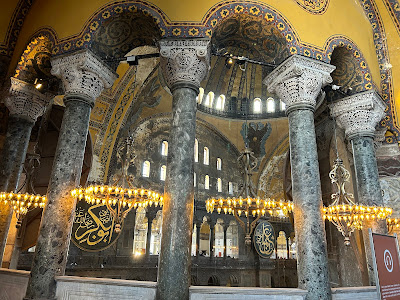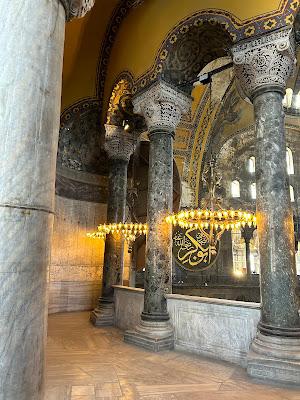The Ayasofya (Full Name: Ayasofya-i Kebir Cami-i Şerifi, or The Grand Mosque of Aya Sofia) inherits its name from the former Greek name Hagia Sophia (Ἁγία Σοφία) or Church of Holy Wisdom. This is the third church that has stood on this site: the first was built by the Emperor Constantius II during the mid-fourth Century A.D. and consecrated in A.D. 360; the second was built by the Emperor Theodosius II in the late fourth/early fifth Century A.D. and consecrated in A.D. 415.
 |
| Looking towards the Ayasofya from the Hippodrome |
In A.D. 532 as part of the outcome of the Nika Riots (where, as you may recall, the Emperor Justinian had up to 30,000 citizens murdered in the vicinity of where the above picture was taken, the Hippodrome), the existing church burned. The Emperor Justinian - he the builder of the Basilica Cistern we visited earlier, as well as the reconquest of Italy and North Africa and establishment of the legal corpus known as the Code of Justinian - made no small plans here either; he desired to build a church like no other. Fortunately the church was now gone, which made a redesign convenient. Within three weeks of the burning of the Second Hagia Sophia, the third construction - our current one- was initiated.
 |
| (Entrance) |
 |
| (View of the ceiling above the entrance - A.D. 6th century brick) |
 |
| (Interior View of the Ceiling) |
(View of the hall of the second floor)
The finished construction was not without issue. The construction was rushed and partially as result, perhaps more prone to earthquakes. A smaller dome collapsed in A.D. 558. Justinian ordered the restoration; The main vault was redesigned and raised another 20.5 ft to a height of 182 ft./55.6 m. which is its current height. That was certainly not the last repair to the structure, which has gone numerous restorations (not surprising, given the geologic activity in the area). The church remained the largest church in Europe for 1,000 years, until the construction of the Seville Cathedral.
(View of the main interior)
The Dome of Hagia Sophia remains one of the great marvels of late Antiquity/early Medieval architecture, as it is the largest pendentive dome in its time and up to the completion of St. Peter's Cathedral in Rome. In broken non-architect language, they put a round dome on a square base by having the corners of the square based transfer the weight down. Wikipedia's article has a much fuller description. Short story: No one had really done this before.
 |
| (The Dome of Hagia Sofia) |
The interior of the church was sheathed in marble and mosaics decorated it.
 |
| (Capital of a column) |
 |
| (Balustrade) |
The church functioned as the heart of Orthodox Christendom for almost 1,000 years. It was the scene of every sort of drama that one could possibly imagine for the main cathedral of an Empire.
 |
| (View of the main floor towards the back) |
 |
| (View of the side of the church) |
The last Christian service held in the Hagia Sophia was likely performed on 29 May A.D. 1453, when the inhabitants of Constantinople prayed for deliverance. Sometime during that day, the city fell to the Ottoman Turks and the priests were prevented from continuing their services.




We usually make it a point to visit a church on every vacation. They are usually great examples of architecture and culture of the area.
ReplyDeleteEd, we usually do as well. Some countries are definitely more impressive than others - for example, the cathedral in Reykjavik was big and scenic, but far too modern for my taste. We were fortunate in that we have been able to see some very unique churches, like this one and St. Demetrius' in Thessaloniki.
DeleteQuite the collection of photos TB, thanks for the brief visit into the past.
ReplyDeleteYou are welcome, Nylon12. I do not formally keep a "bucket list", but Hagia Sophia was on it. I can only imagine what chanted services in there must have been like, with the incense coiling up.
DeleteImpressive structure and interesting history, one I'm only vaguely familiar with. And what a contrast to architecture today. To construction today. Hard to imagine anything we build now lasting this long.
ReplyDelete(Sorry Leigh - Somehow these got away from me!).
DeleteYes, it really is a contrast. We build nothing today like this.